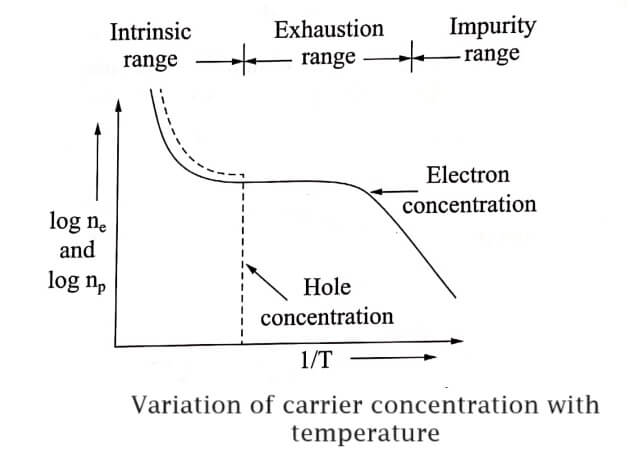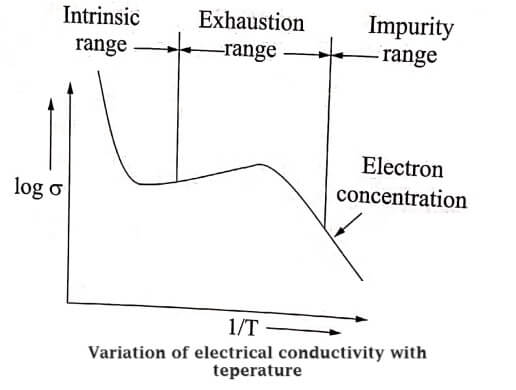The variation of carrier concentration with temperature for a n-type semi conductor is shown in Fig.
At 0K both the conduction band and valence band are free from any charge carriers and hence conductivity is zero.
Now, when the temperature is slowly increased, the donor atoms get ionized and hence, the electron concentration in conduction band increased. Since this range occurs due to impurity atoms ionization this region is called impurity range.
When the temperature is further increased, say at about room temperature, all the donor atoms are ionized and so, the concentration of electrons in the conduction band remains constant over a certain range of temperature. This range is called the exhaustion range.
As the temperature is increased further, and if the thermal energy is sufficiently high, the covalent bonds get broken and thus electron-hole pairs are generated. As a result, electrons from the valence band starts moving towards the conduction band the thereby increasing the electron concentration in the conduction band considerably.
Thus, with continuous increase of temperature, more and more electrons from the valence band reach the conduction band and completely outnumber donor electrons. The Fermi level moves down gradually until it reaches the middle of the forbidden gap. The material becomes intrinsic and this range is called intrinsic range.

Hole Concentration
The dotted curve indicates the hole concentration. In the intrinsic range both the hole and electron concentration curves overlap since they becomes equal in number. The exhaustion range is observable only for smaller concentration of Nd. If Nd is large, the low temperature impurity region extends towards intrinsic region.
Note: The variation of carrier concentration with temperature for a p-type semiconductor can also be explained in the similar manner.
Conductivity of extrinsic semiconductor
The variation of conductivity with increase of temperature of an extrinsic semiconductor is shown in Fig.
At low temperature, near absolute zero, only few of the impurity atoms get ionised and hence the conductivity low.
As the temperature is increased further, more and more of the impurity atoms get ionised and so conductivity s increases. But this increase in log s is gradual due to large impurity scattering and the availability of small amount of carriers.

At higher temperature the carrier density increases enormously and so the conductivity increase steeply. At high temperature the material becomes practically intrinsic.
| Read More Topics |
| Difference between N & P type semiconductor |
| Extrinsic semiconductors (P-type and N-type) |
| Elemental and compound semiconductors |





